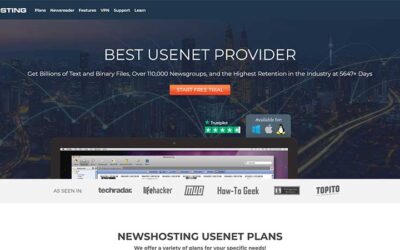Understanding Usenet Connections: What They Are and How They Affect Download Speed
When choosing a Usenet provider, one of the most frequently advertised features is the number of connections available-10, 20, 50, or even 100. If you’re new to Usenet, you might be wondering: What exactly is a Usenet connection? How does the number of connections affect your download speed? And, perhaps most importantly, how many connections do you actually need?
This guide will break it all down in simple terms, helping you make informed decisions about your Usenet setup.
What Are Usenet Connections?
A Usenet connection refers to an individual link between your Usenet client (also called a newsreader) and your Usenet provider’s servers. Each connection allows your newsreader to request and retrieve articles or file segments from the provider’s server.
Think of it like downloading a large file using multiple threads-each thread works on a different part of the file, speeding up the overall download process. The more connections you use, the more parts of a file you can retrieve at the same time.
Usenet operates using NNTP (Network News Transfer Protocol), which allows multiple simultaneous requests. Instead of downloading files sequentially, you can use multiple NNTP connections to fetch different parts in parallel, improving efficiency.
How Do Multiple Connections Affect Speed?
More connections generally mean faster downloads-but only up to a point. Here’s why:
- Parallel Downloading – Large Usenet files are typically split into smaller segments and spread across different servers. When you download a file, your Usenet client grabs multiple segments at once, reassembling them after completion. More connections allow your client to request and download more segments simultaneously, which can speed up retrieval.
- Maximizing Your Bandwidth – If you have a high-speed internet connection (e.g., 500 Mbps or 1 Gbps), a single Usenet connection may not be enough to fully utilize your available bandwidth. Multiple connections allow you to pull data at a faster rate by overcoming potential bottlenecks between your ISP and the Usenet server.
- Compensating for Slow or Throttled Servers – Some Usenet servers may limit the speed per connection to prevent excessive strain. By increasing the number of connections, you can bypass per-connection limitations and achieve the highest possible download speed.
However, there is a limit to how beneficial extra connections are. If you already have enough connections to saturate your internet connection, adding more won’t make your downloads any faster. In some cases, using too many connections can even slow things down due to server strain, overhead processing, and ISP throttling.
How Many Connections Do You Actually Need?
The optimal number of connections depends on several factors:
1. Your Usenet Provider’s Connection Limit
Each Usenet provider sets a maximum number of connections per user. Common limits include 10, 20, 50, or even 100 connections. However, just because a provider offers 100 connections doesn’t mean you need to use all of them.
Some premium Usenet providers, such as Fast Usenet, UsenetServer, and Newshosting, offer speeds well over 1 Gbps. If you have a high-speed internet connection, using around 10-20 connections is usually sufficient.
2. Your Internet Speed
If your ISP provides a lower-speed connection (e.g., 100 Mbps or less), you probably don’t need more than 5-10 connections to reach full speed. More connections won’t make a difference because your internet speed is the limiting factor.
If you have a faster connection (e.g., 500 Mbps or 1 Gbps), you may benefit from 20-40 connections, depending on your provider’s server speeds and whether your ISP throttles Usenet traffic.
3. Server Load and Performance
Too many connections can actually slow things down if the Usenet provider’s servers are overloaded or if your ISP struggles to handle multiple simultaneous downloads. Using excessive connections can lead to:
- Increased server response time
- Higher CPU usage on your local system
- Unnecessary network congestion
A good practice is to start with around 10 connections and gradually increase until you reach your maximum download speed.
4. ISP Throttling and Traffic Management
Some internet service providers throttle Usenet traffic, limiting the speed regardless of how many connections you use. If you suspect this is happening, try:
- Using SSL encryption (port 563 or 443) to hide Usenet traffic from your ISP.
- Limiting your total connections to avoid triggering ISP traffic shaping.
- Using a VPN to prevent Usenet-specific speed restrictions.
Usenet Connection Myths Debunked
Myth 1: More Connections Always Mean Faster Speeds
- Reality: Once you’ve maxed out your bandwidth, adding more connections does nothing. If you already have enough to fully use your internet speed, adding more just wastes system resources.
Myth 2: You Should Always Use the Maximum Connections Allowed
- Reality: Using only as many connections as needed is best. More connections can sometimes slow down performance due to server strain and network congestion.
Myth 3: Free Usenet Providers Offer the Same Connection Speeds
- Reality: Most free Usenet services severely limit connections and speed. Paid providers like Fast Usenet, UsenetServer, and Newshosting allow high-speed downloads with more reliable connections.
Best Practices for Configuring Usenet Connections
To optimize your Usenet experience, follow these best practices:
✔ Start with 10-15 connections and increase gradually if needed.
✔ Use SSL encryption (port 563 or 443) to prevent ISP throttling.
✔ Monitor your download speed and adjust connections accordingly.
✔ Check your provider’s max connection limit and stay within it.
✔ Use a quality Usenet provider with robust infrastructure.
Final Thoughts: Finding the Right Balance
Understanding Usenet connections is crucial for optimizing your downloads. While having more connections can help speed things up, there is a limit-and using too many connections can sometimes be counterproductive.
The best approach is to experiment with different connection settings based on your internet speed, provider, and download habits. With the right balance, you’ll enjoy fast, uninterrupted Usenet downloads without unnecessary strain on your system or network.
By fine-tuning your connection settings, you can get the most out of your Usenet subscription while ensuring a smooth and efficient downloading experience.




